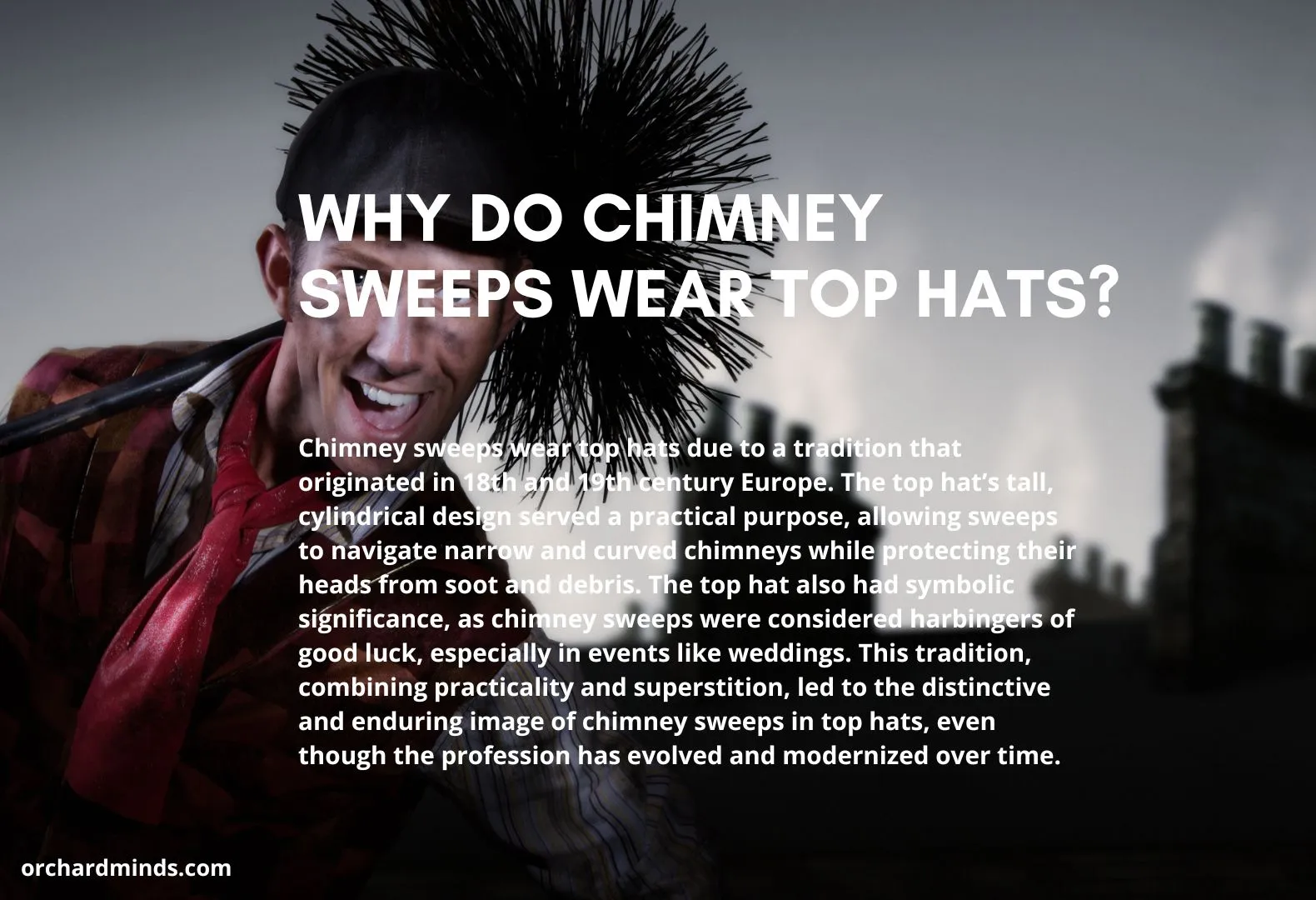Chimney sweeps wear top hats because of a tradition started in 18th and 19th century Europe. It was the tall, cylindrical design that made the top hat useful to any sweep. The crown protected them from chimneys not only narrow but sometimes curved.
The top hat also held some symbolic value, as being a chimney sweep was considered the forerunners of good luck to occurrences such as weddings. This tradition incorporated practicality and superstition in a classic way that has left an impressionable image of the chimney sweep image donning top hats, even when the profession has since evolved to modernize.
History of the Chimney
The chimney stands as a testament to history, as areas of centuries-old development in architecture and heating. Chimneys have led the way for a safer and more efficient mode of heating and ventilation for humans. The earliest chimneys can be dated back to ancient times. For example, some houses in ancient Egypt had primitive chimneys, fabricated from fired clay and utilized for venting smoke and fumes from open fires. There were also formative forms of chimneys in ancient Rome, known as hypocausts; they had them as part of their central heating systems. Hypocausts circulated the hot air underneath the floors and through the walls of buildings.
However, it was in medieval Europe that the chimney as we know it began to take shape. Before chimneys saw widespread use, homes were often heated and cooked with open hearths directly in the middle of the room. In this regard, fumes and smoke did not clear out of the house, resulting in poor indoor air quality. The development of the chimney changed this. The first chimneys were simply a straight passage of stone or brick. They enabled a fireplace to be built into a building on a flue that transported smoke and gases up and out from the structure. This was an improvement to the air quality inside the house; a great step forward for comfort and safety. The Tudor period would see the chimney undergo further refinement in England. Chimneys were typically tall with decorative chimney stacks, serving to show off the social status and the amount of wealth a person in that home possessed. Bravo end.
With time, chimneys further evolved. Throughout the early industrial revolution itself, improvement in construction materials and methods led to the possibility of building more complex and efficient chimney systems for factories and industrial buildings. Improvements are also marking the 19th and 20th centuries with innovations like chimney liners that further improve safety and draft efficiency. The advent of central heating and cleaner-burning fuels reduced the dependency on single-room fireplaces but did not reduce the importance of chimneys in venting the byproducts of combustion.
The chimneys of today have architectural diversity—running from traditional brick chimneys in older dwellings to contemporary metal-flue construction in newer ones.
Even if the many functions that were designed for chimneys are taken over by central heating systems and ventilation systems, chimneys will always be indispensable parts of homes and industries. They stand on the front line when it comes to venting fireplaces, wood-burning stoves, and heating equipment, all moving toward adapting to cleaner, more efficient heating technologies. The chimney speaks for itself in the history of humanity, where it stands as an oblation to human ingenuity and adaptability in making their living space comfortable, safe, and efficient.
Hand-me-downs
It is said that one of the reasons why chimney sweeps wear top hats is that they used to be the lowest social class workers in 18th and 19th century England. During that era, the upper class would commonly get rid of their older but, at the same time, high-quality top hats. These top hats that had been thrown away would end up being put to use by chimney sweeps, who wore the soot-stained headpieces for both practical purposes in their dirty work and as a form of dressing up in a piece of attire that represented higher social standing.
A gift from the monarch
Yet another tells us that top hats were gifted to chimney sweeps by King George III.
The story goes that the King took pity on the plight of a soot-begrimed chimney sweep and gave it to him. This kingly act initiated the fad in which discriminatory chimney sweeps, feeling most undignified in only carrying on their craft attired in bare heads like common people, began to sport top hats. But again, while this story is disputed by historians, it fueled the custom of top-hatted chimney sweeps.
A Good Luck Symbol
Beyond the practicality, the top hat of the chimney sweep also picked up superstitions and symbolism. Chimney sweeps have long been considered as an omen of good luck by the people of many cultures. For example, they believed that meeting a chimney sweep on a wedding day brought good fortune and vast happiness to the new family. This begot the tradition of inviting chimney sweeps to weddings, to bless the union, many times to even perform some sort of dance. In these more ceremonial types of outfits, it is the top hat that became central, really cementing its role as a symbol of luck and celebration.
A Vanishing Tradition
Although the vision of soot-faced chimney sweeps in top hats is a rare sighting today, the history and symbolism are kept alive within other contexts. Some contemporary chimney sweeps still wear their top hats, but usually only at chimney sweep festivals and parades. Furthermore, that image of the chimney sweep has come to represent nostalgia and romance in a bygone age, when the coziness of a warm home resonated with the expertise of precisely such individuals.



Leave a Comment